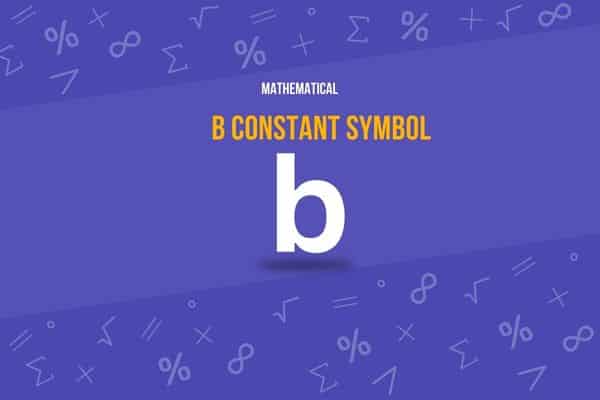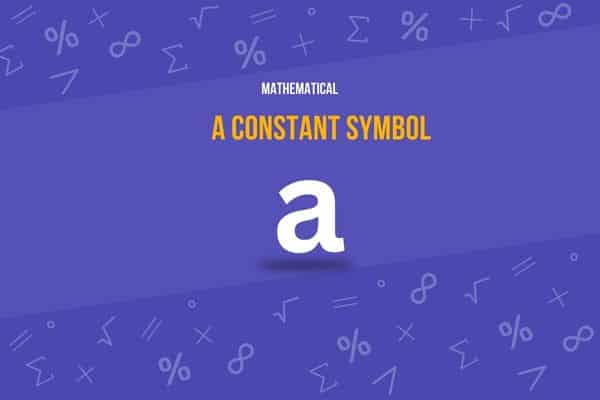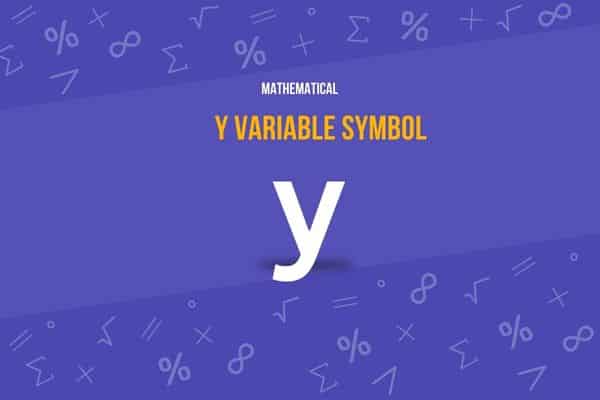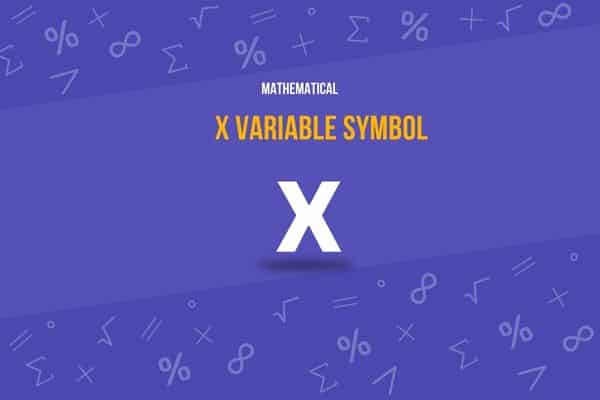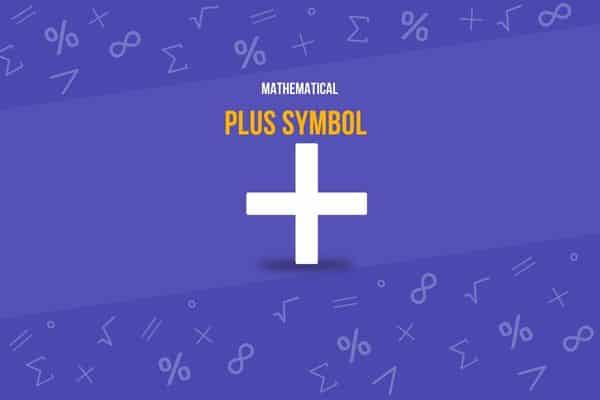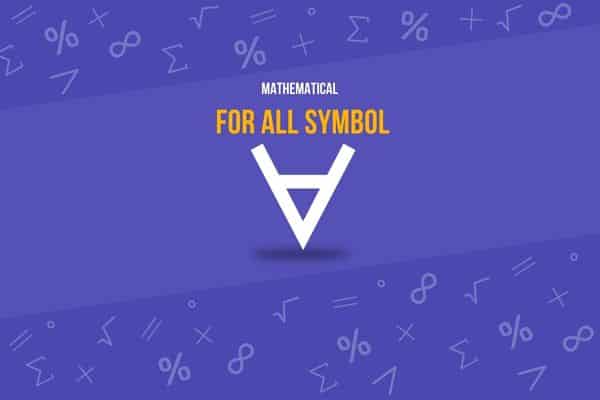What is the Differential Symbol?
How often do you find yourself in a situation where you’re stuck with mathematical symbols that seem to be written in another language? Well, you’re certainly not alone. Today, we will demystify one such symbol – the differential symbol.
You might recognize it as that little ‘d’ in mathematical equations, often standing beside a variable. This simple yet profound symbol plays a significant role in calculus, particularly differentiation and integration.
But there’s much more to the differential symbol than initially meets the eye.
Let’s get started!
Fast Facts
d
Differential Symbol
Differential Symbol (d/dx) Overview
Here is a detailed table providing comprehensive information about the differential symbol “d”:
| Attribute | Detail |
|---|---|
| Symbol Name | Differential “d” |
| Unicode | U+1D451 |
| Image | 𝑑 |
| Brief Description | A mathematical symbol used to denote infinitesimal changes in variables, commonly used in derivatives and integrals. |
| Unicode Version and Date | Unicode 4.1, released in March 2005 |
| Unicode Block Name | Mathematical Alphanumeric Symbols |
| Plane | Supplementary Multilingual Plane (SMP) |
| Script | Common |
| Category | Lowercase Letter |
| Bidirectional Class | Left-To-Right (L) |
| Combining Class | 0 (Not Reordered) |
| Character is Mirrored | No |
| HTML Entity | 𝑑 |
| CSS | \1D451 |
| UTF-8 Encoding | F0 9D 91 91 |
| UTF-16 Encoding | D835 DC51 |
| UTF-32 Encoding | 00 01 D4 51 |
| ASCII Code | Not applicable (outside ASCII range) |
Here’s What You Will Find
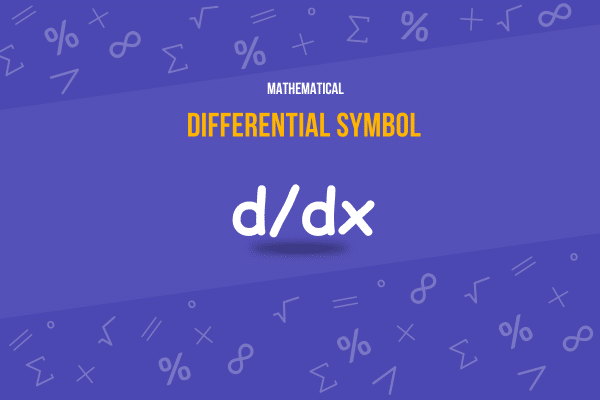
Differential Symbol
The differential symbol, denoted by a small ‘d’, is an integral part of calculus. It means an infinitesimally small change in a variable. Primarily seen in differential and integral calculus, this symbol is used to express derivative operations and is fundamental in defining concepts such as the derivative and differential of a function.
In practical terms, the differential symbol represents a small difference in a certain quantity that results in another change, no matter how minuscule. Understanding this key symbol opens the door to a better grasp of advanced mathematical concepts with applications spanning physics, engineering, economics, and beyond.
Other Names
The differential symbol is generally referred to by its standard name in mathematics. However, depending on the context and application, it might also be known more descriptively. In differential calculus, it’s often called the derivative symbol, as it’s used to indicate the derivative of a function.
When used in integral calculus, it might be referred to as the integration differential since it denotes the variable of integration in an integral. While these names all essentially refer to the same symbol, they reflect its versatility and wide-ranging utility in various mathematical disciplines.
Differential Symbol Meaning
The differential symbol “d” is a fundamental mathematical symbol used in calculus to denote differentiation and integration of functions. In derivatives, the differential “d” represents infinitesimal variable changes.
For example, in the derivative expression (\frac{dy}{dx}), “dy” and “dx” represent the infinitesimal changes in the variables “y” and “x,” respectively.
Did You Know?
The differential symbol originates from the Latin word “differentia,” which means difference.
The differential symbol use was popularized by Gottfried Wilhelm Leibniz, who was co-credited with the development of calculus alongside Isaac Newton. In integral calculus, the differential “d” precedes a variable to indicate integration concerning that variable, as seen in integral expressions like (\int f(x) \, dx), where “dx” signifies integration with respect to “x.”
This notation is essential in theoretical and applied mathematics. It facilitates precise calculations involving rates of change and cumulative sums and is pivotal in fields such as physics, engineering, and economics.
The differential symbol, usually denoted as a lowercase ‘d’, is a significant figure in calculus, signifying an infinitesimally small change or variation in a variable. It’s integral to defining and understanding the concepts of differentiation and integration. The primary purpose of this symbol is to illustrate the rate at which one quantity changes about another.
For example, in the equation dy/dx, where ‘y’ is a function of ‘x,’ dy signifies a tiny change in ‘y’, and dx represents a small change in ‘x’. The ratio dy/dx then defines the derivative of ‘y’ concerning ‘x’, the rate at which ‘y’ changes for each unit change in ‘x.’
In integral calculus, the differential ‘dx’ signifies the variable over which the function is integrated. Beyond its use in fundamental calculus, the differential symbol is also featured in more complex mathematical situations, such as differential equations and multivariate calculus. A differential symbol is pivotal in expressing change and variation in mathematical terms.
Differential Symbol Unicode
Unicode is a standardized system of encoding characters and symbols used worldwide. This computing industry standard is designed to represent text expressed in any writing system consistently. From Latin alphabets and Greek symbols to Chinese characters and emoji, Unicode assigns each character and symbol a unique numeric value, known as its Unicode value. This system ensures that text data is processed, stored, and transmitted consistently across different devices and platforms.
Now, when it comes to the differential symbol, typically represented by a lowercase ‘d’, the standard Unicode value is U+0064.
However, remember that this corresponds to a standard lowercase ‘d’ in the Latin alphabet. For representing differentials in mathematical notation, you might also see U+1D451, the Unicode for the mathematical italic small ‘𝑑’. Remember, while they look similar, they are not the same, as each Unicode character has its specific usage and meaning.
Differential Symbol Uses
The differential symbol, designated by a small ‘d’, is a crucial tool within mathematics and beyond. Predominantly utilized within calculus, it denotes an infinitesimally small alteration in a variable.
The differential symbol “d” is integral to calculus and appears in various mathematical contexts, reflecting its foundational role in representing changes and rates of change. Here are some key uses of the differential symbol “d”:
Derivatives
In calculus, the differential “d” is used to denote the derivative of a function. For instance, if (y = f(x)), the derivative is written as (\frac{dy}{dx}), representing the rate of change of (y) with respect to (x).
Differential Equations
The symbol is crucial in formulating differential equations, which involve derivatives of functions. These equations describe phenomena where the rate of change of one variable is related to the value of other variables, such as population growth, heat conduction, and motion dynamics.
Integration
In integral calculus, “dx” appears in the integral sign (\int) to indicate integration with respect to (x). This usage is essential for calculating areas, volumes, and other quantities that arise from accumulating infinitesimal units.
Multi-variable Calculus
In the context of multiple variables, differentials like (dx), (dy), and (dz) perform partial differentiation and multiple integrals, which are essential in fields such as physics, engineering, and economics.
Physics and Engineering
The differential symbol is used extensively in physics to denote small changes in physical quantities, such as distance, time, and temperature. For example, (ds) might represent an infinitesimal displacement vector in space, while (dt) could represent an infinitesimal change in time.
Economics
In economics, differentials are used to calculate marginal costs, profits, and utility functions. For example, (dC) could represent the change in cost function relative to an output (dq).
Theoretical Mathematics
Beyond applied sciences, “d” is used in theoretical contexts to explore properties of functions and spaces, such as in differential geometry and the study of manifolds, where differentials contribute to understanding curvature, topology, and other complex properties.
These examples showcase the differential symbol “d” as a pivotal element in a broad spectrum of mathematical applications, emphasizing its critical role in describing and analyzing both natural phenomena and theoretical constructs.
When it comes to differentiation, this symbol signifies the derivative of a function, effectively assisting in quantifying how a shift in one variable influences another. In integral calculus, the differential symbol specifies the variable over which integration is performed, acting as an indispensable part of the integral notation. In the world of differential equations, it helps articulate how quantities evolve about one another.
Moreover, differentials are fundamental in numerous practical applications, such as defining motion and forces in physics, modeling systems in engineering, and studying rate changes in economics. Consequently, comprehending the differential symbol isn’t just pivotal to grasping advanced mathematics and understanding its far-reaching implications in various scientific and technological domains.
Differential Symbol Examples
Let’s illustrate the usage of the differential symbol with an example from physics.
The differential symbol “d” plays a crucial role in calculus and related mathematical fields, serving as a fundamental component in various expressions and calculations. Here are several practical examples that illustrate the diverse applications of the differential symbol:
Basic Calculus
- Example 1: Finding the derivative of the function ( f(x) = x^2 ). Using the differential notation, the derivative is represented as ( df = 2x \, dx ). This means the infinitesimal change in ( f ) is ( 2x ) times the infinitesimal change in ( x ).
- Example 2: Calculating the integral of ( g(x) = 3x^3 ) from ( x = 0 ) to ( x = 2 ). The integral expression is written as ( \int_0^2 3x^3 \, dx ), which evaluates the accumulated area under the curve of ( g(x) ) over the interval from 0 to 2.
Physics Applications
- Work Done by a Force: If a force ( F ) is applied to move an object along a path, the work done is calculated by integrating the force along the path, represented as ( W = \int F \, ds ), where ( ds ) is the differential segment of the path over which the force is applied.
- Electric Field: The electric field created by a charge distribution can be expressed as ( E = \int \frac{dq}{r^2} ), where ( dq ) is the infinitesimal charge and ( r ) is the distance from the charge element to the point of interest.
Economics
- Marginal Cost: The marginal cost, which is the cost to produce one additional output unit, can be approximated by ( dC ), where ( C ) is the cost function. This is useful in optimizing production levels to minimize costs or maximize profits.
Engineering
- Heat Transfer: In the study of heat transfer, the rate of heat transfer through a differential area can be modeled as ( dQ = kA \frac{dT}{dx} \, dx ), where ( k ) is the thermal conductivity, ( A ) is the area, ( dT/dx ) is the temperature gradient, and ( dx ) is the thickness of the differential element.
Biological Sciences
- Population Growth: In models of population dynamics, the change in population size ( P ) over time can be described by ( dP = rP \, dt ), where ( r ) is the growth rate and ( dt ) is an infinitesimal time interval.
These examples demonstrate how the differential symbol “d” is employed to describe incremental changes and to integrate these changes over a range, providing powerful tools for solving complex problems across various scientific and technical fields.
Here is a simple example:
Consider a car moving at a certain speed. The change in its position over time (displacement) is described by the speed multiplied by the time interval. This situation can be expressed in terms of calculus using the differential symbol. If ‘s’ represents the position of the car and ‘v’ is its velocity, the infinitesimally small change in the car’s position (ds) over an infinitesimally small duration (dt) would be given by the equation ds = v dt.
Here, ‘ds’ and ‘dt’ represent differential quantities close to 0. This equation essentially states that the tiny change in the car’s position equals its velocity times the tiny change in time. This showcases the application of the differential symbol in real-world scenarios, helping us to understand the intricate dynamics of motion.
Why is the Differential Symbol Important?
As a fundamental building block of calculus, the differential symbol helps to quantify how tiny changes in one variable affect another. This mechanism forms the basis for exploring and understanding the behavior of dynamic systems, whether in physics, engineering, economics, or numerous other disciplines. The differential symbol facilitates our capacity to analyze rates of change and to solve complex differential equations that model real-world phenomena.
The differential symbol’s role is crucial, from predicting a satellite’s trajectory to calculating an economy’s growth rate. Without it, our ability to understand and navigate the intricacies of the natural and technological worlds would be significantly hampered.
Differential Symbol History
The history of the differential symbol traces back to the 17th century when Sir Isaac Newton and Gottfried Wilhelm Leibniz co-invented calculus. While both pioneers made immense contributions, the notation we use today, including the differential symbol, is largely credited to Leibniz. Despite initial controversy and conflict over the credit for calculus, Newton’s and Leibniz’s work form the cornerstone of modern mathematical understanding.
The history of the differential symbol “d” is deeply intertwined with the development of calculus. This mathematical innovation has fundamentally changed our approach to understanding dynamics, rates of change, and accumulation. This section explores the evolution of this pivotal mathematical symbol:
Origins in Ancient Problem Solving
Long before the formalization of calculus, mathematicians from ancient civilizations like the Greeks and Egyptians engaged in rudimentary forms of what would later be known as differentiation and integration. These early methods, used to solve problems involving areas and volumes, did not involve a formal symbolic representation but laid the groundwork for later mathematical innovations.
Formal Introduction by Leibniz
The modern differential symbol “d” was introduced by Gottfried Wilhelm Leibniz in the late 17th century. Leibniz, alongside Isaac Newton, is credited with the co-creation of calculus. Leibniz introduced “d” as a shorthand for “difference” or “differential,” to denote infinitesimal changes in variables. This was part of his broader effort to create a systematic and coherent symbolic language for calculus, which marked a significant departure from the geometric approaches previously used to describe similar concepts.
Leibniz’s Notation vs. Newton’s Notation
Leibniz’s notation, including the differential symbol “d,” competed with Isaac Newton’s fluxional notation, where rates of change were indicated by placing dots over the variables. Leibniz’s notation proved to be more practical and intuitive, especially for the formulation of differential equations and the performance of integration, which led to its widespread adoption in the mathematical community.
Expansion in Mathematical Application
As calculus began to develop and expand, the differential symbol “d” became a standard tool in mathematics physics, engineering, and other sciences. It facilitated the expression of concepts ranging from rates of change in motion (dynamics) to the transfer of heat in thermodynamics.
Standardization and Modern Usage
Throughout the 18th and 19th centuries, as the study of calculus became more refined and widespread, the differential symbol “d” was standardized across mathematical texts. Today, it remains a fundamental component of mathematical notation, used globally in education, research, and practical applications in various scientific fields.
The history of the differential symbol “d” reflects the broader narrative of mathematical progress, illustrating how symbolic notation can evolve in response to advancing mathematical thought and the practical needs of scientists and mathematicians.
Today, the differential symbol ‘d’ that Leibniz introduced remains an essential part of mathematics, particularly calculus, highlighting the lasting impact of his contributions.
Differential Symbol Origin
The ‘d’ was chosen to represent an infinitesimally small increment in a variable, borrowing from the Latin word “differentia,” which means difference. Leibniz’s notation was more intuitive and easier to manipulate than Newton’s; over time, it became the predominant notation for derivatives.
The origin of the differential symbol “d” is intricately linked to the historical development of calculus, a branch of mathematics central to understanding and modeling change. The symbol itself, now ubiquitous in mathematical and scientific disciplines, was popularized by the German mathematician Gottfried Wilhelm Leibniz during the 17th century. Here’s a closer look at how the differential symbol emerged:
Leibniz’s Innovative Contribution
Leibniz is credited with introducing the differential symbol “d” as part of his formulation of differential calculus. He chose “d” to represent “differential” or “difference,” indicating a small, infinitesimal change in a variable. This choice was aligned with his broader mathematical philosophy that sought to symbolize concepts clearly and efficiently to facilitate easier computation and understanding.
Philosophical Underpinnings
Leibniz’s choice was deeply influenced by his philosophical views on continuity and infinitesimal change. He believed any continuous change could be expressed as the sum of infinitely many infinitesimal changes. Thus, the symbol “d” became a fundamental part of expressing these infinitesimal elements in calculus, encapsulating changes across an infinitely small interval.
Competition with Newton’s Notation
Simultaneously, Isaac Newton was developing his methods for calculus in England, known as fluxions, where he used dots above variables to denote rates of change. Although effective, Newton’s notation was less intuitive for forming and solving differential equations than Leibniz’s. Over time, the clarity and utility of Leibniz’s notation, including the use of “d” for differentials, led to its broader adoption in academic and practical applications.
Formal Adoption and Spread in Mathematics
The adoption of Leibniz’s notation was not immediate. However, it gained favor in the mathematical community due to its simplicity and ease of use, particularly as calculus began to be applied more broadly across Europe. By the 18th century, Leibniz’s notation had become standard in mathematical texts, outpacing alternative methods.
Lasting Impact
Today, the differential symbol “d” is foundational in calculus and related fields, symbolizing the derivative of functions and integration processes. Its origin reflects a pivotal moment in mathematical history, where the need for a concise and practical notation system drove the evolution of symbolic representation in mathematics.
The differential symbol’s origin story is a testament to how mathematical symbols are not merely tools for calculation but are also deeply influenced by their time’s theoretical perspectives and practical requirements. The “d” symbol remains a core element of mathematical notation, illustrating the lasting influence of Leibniz’s contributions to calculus.
Evolution of the Differential Symbol
The differential symbol, denoted as ‘d, ‘ has remained relatively consistent since Gottfried Wilhelm Leibniz introduced it in the late 17th century. However, the symbol’s understanding, interpretation, and application have evolved. Initially, it was used to denote infinitesimal increments in variables. The concept of infinitesimals was controversial and often poorly understood in Leibniz’s time.
With the development of calculus and mathematical rigor in the 19th century, the interpretation of the ‘d’ symbol became more formalized. It now represents a limit of the ratio of changes in quantities, aligning with the modern definition of a derivative in calculus. Despite the evolution of its interpretation, the form of the differential symbol has largely remained unchanged, serving as a testament to the enduring power of Leibniz’s notation.
Differential Symbol In Everyday Life
Understanding the differential symbol deepens our appreciation for mathematics and provides a fresh perspective on our daily lives. At its core, the differential symbol represents small changes, reminding us of the impact that incremental adjustments can have over time. As in calculus, where the accumulation of infinitesimal changes can lead to significant shifts, applying this principle to our routines can result in meaningful transformation.
Whether it’s dedicating a few more minutes to a hobby, incorporating a healthier food choice into your diet, or taking a brief moment each day to practice mindfulness, these seemingly tiny modifications, much like differentials, can add up over time and significantly influence our lives. This embodiment of the concept behind the differential symbol allows us to recognize the power of incremental change, instilling a sense of patience, consistency, and long-term thinking in our daily habits and overall life journey.
Last Thoughts
As we’ve seen, the humble differential symbol profoundly represents change and variation, resonating within and beyond calculus’s boundaries. We encourage you to continue your journey of discovery. Dive into the fascinating world of other mathematical symbols and signs – each has a story and a unique role to play. And why not bring some mathematical wonder into your daily life?
Check out merchandise inspired by the differential symbol and other mathematical icons. From T-shirts and mugs to posters and notebooks, there’s something for every math enthusiast. Remember, every symbol has a tale, a purpose, and an impact.
Before You Go
We invite you to continue your mathematical adventure by exploring other symbols. Each one unlocks a new chapter in the fascinating story of mathematics and its profound influence on our understanding of the world.
We hope you found our deep dive into the uses and applications of the differential symbol “d” both informative and engaging! If you think others might benefit from this exploration into one of calculus’s foundational elements, why not share this post with your network?
This post can offer valuable insights to students facing their first calculus course, professionals brushing up on their skills, or enthusiasts who cherish the beauty of mathematics.
Sharing knowledge is a great way to inspire and foster a deeper appreciation for the intricate world of mathematics.

